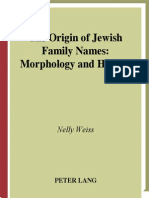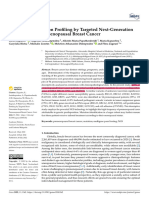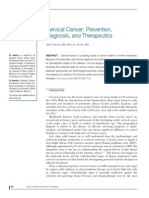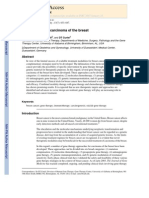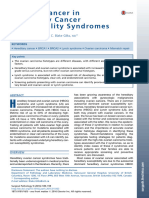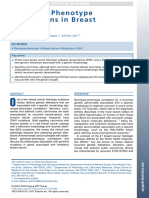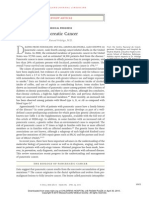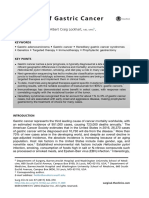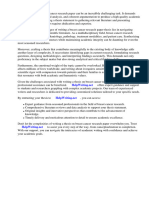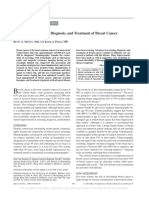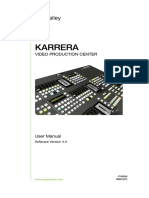0 ratings0% found this document useful (0 votes)
34 viewsCancer Volume 70 Issue Supplement S4 1992 - Genetic Predisposition To Breast Cancer
Cancer Volume 70 Issue Supplement S4 1992 - Genetic Predisposition To Breast Cancer
Uploaded by
Apache313This document discusses genetic predisposition to breast cancer. It summarizes the current understanding that some cases of breast cancer are hereditary and linked to specific genetic mutations or loci. Research is ongoing to identify these genetic factors through techniques like linkage analysis and gene cloning. At least three major breast cancer susceptibility loci have been identified so far. Further research may help determine the percentage of breast cancer cases attributable to genetic factors and help develop improved prevention and treatment strategies.
Copyright:
© All Rights Reserved
Available Formats
Download as PDF, TXT or read online from Scribd
Cancer Volume 70 Issue Supplement S4 1992 - Genetic Predisposition To Breast Cancer
Cancer Volume 70 Issue Supplement S4 1992 - Genetic Predisposition To Breast Cancer
Uploaded by
Apache3130 ratings0% found this document useful (0 votes)
34 views8 pagesThis document discusses genetic predisposition to breast cancer. It summarizes the current understanding that some cases of breast cancer are hereditary and linked to specific genetic mutations or loci. Research is ongoing to identify these genetic factors through techniques like linkage analysis and gene cloning. At least three major breast cancer susceptibility loci have been identified so far. Further research may help determine the percentage of breast cancer cases attributable to genetic factors and help develop improved prevention and treatment strategies.
Original Description:
Genetic predisposition to Breast Cancer
Original Title
Cancer Volume 70 Issue Supplement S4 1992-- Genetic Predisposition to Breast Cancer
Copyright
© © All Rights Reserved
Available Formats
PDF, TXT or read online from Scribd
Share this document
Did you find this document useful?
Is this content inappropriate?
This document discusses genetic predisposition to breast cancer. It summarizes the current understanding that some cases of breast cancer are hereditary and linked to specific genetic mutations or loci. Research is ongoing to identify these genetic factors through techniques like linkage analysis and gene cloning. At least three major breast cancer susceptibility loci have been identified so far. Further research may help determine the percentage of breast cancer cases attributable to genetic factors and help develop improved prevention and treatment strategies.
Copyright:
© All Rights Reserved
Available Formats
Download as PDF, TXT or read online from Scribd
Download as pdf or txt
0 ratings0% found this document useful (0 votes)
34 views8 pagesCancer Volume 70 Issue Supplement S4 1992 - Genetic Predisposition To Breast Cancer
Cancer Volume 70 Issue Supplement S4 1992 - Genetic Predisposition To Breast Cancer
Uploaded by
Apache313This document discusses genetic predisposition to breast cancer. It summarizes the current understanding that some cases of breast cancer are hereditary and linked to specific genetic mutations or loci. Research is ongoing to identify these genetic factors through techniques like linkage analysis and gene cloning. At least three major breast cancer susceptibility loci have been identified so far. Further research may help determine the percentage of breast cancer cases attributable to genetic factors and help develop improved prevention and treatment strategies.
Copyright:
© All Rights Reserved
Available Formats
Download as PDF, TXT or read online from Scribd
Download as pdf or txt
You are on page 1of 8
1747
Genetic Predisposition t o Breast Cancer
Mark H. Skolnick, Ph.D.,* and Lisa A. Cannon-Albright, Ph.D. t
Breast cancer is the most common cancer among Ameri-
can women. Because metastatic breast cancer is an incur-
able disease, efforts to decrease breast cancer mortality
have focused on early detection and improved treatment.
Identification and analysis of a specific genetic suscepti-
bility could permit detection of susceptible women and
greatly increase the understanding of the initial step that
eventually leads to cancer. Because susceptibility loci
have been recognized as sites that often are altered dur-
ing tumor progression, the identification and cloning of
such loci could be important in developing cancer thera-
pies. In this article, the progress being made in segrega-
tion analysis, linkage analysis, and cloning of breast
cancer susceptibility loci is reviewed. The evidence for
genetic inheritance is most consistent with dominant in-
heritance for at least three major susceptibility loci. Pro-
liferative breast disease has been hypothesized to be an
inherited lesion in breast cancer kindreds with both pre-
menopausal and postmenopausal probands. Currently,
there are many genetic markers for mapping the human
genome, Technologic advances have progressed from re-
striction fragment length polymorphisms to highly poly-
morphic markers. Using this technology, breast cancer
susceptibility in some kindreds with an early onset has
been shown to be linked to chromosome 17q. Gene isola-
tion eventually will follow with an increased under-
standing of the percentage of breast cancer cases that are
a result of this genetic locus. Li-Fraumeni syndrome,
which often is expressed as breast cancer, is due to muta-
tions in the p53 gene. Characterization of the syndrome
and its relationship to the altered gene should proceed
rapidly. There is also a group of families exhibiting a ge-
netic susceptibility that is not due to either of these loci.
Together, these findings indicate that there are at least
Presented at the National Conference on Integration of Molecu-
lar Genetics into Cancer Management, Miami, Florida, April 10-12,
1991.
From the Departments of *Medical Informatics and thternal
Medicine, University of Utah Medical Center, Salt Lake City, Utah.
Supported by National Institutes of Health (Bethesda, Mary-
land) grants CA-28854, CA-48711, CA-42014, CN-55428, RR-64,
CA-41591, AM-35378, CA40641, and CA-36362.
Address for reprints: Mark H. Skolnick, Ph.D., Department of
Medical Informatics, University of Utah, 420 Chipeta Way, Room
180, Salt Lake City, UT 84108.
Accepted for publication November 15, 1991.
three separate major loci segregating for breast cancer
susceptibility. With the current initiative to map and se-
quence the entire human genome and the advances that
recently have been reported, a detailed molecular under-
standing of breast cancer predisposition can be envis-
aged. Cancer 1992; 70:1747-1754.
Key words: breast cancer, genetic predisposition, famil-
ial cancer, inheritance.
One of the most promising approaches for understand-
ing the cause of breast cancer and creating an effective
cancer control program is by identifying women who
are genetically predisposed to have this disease. How-
ever, the contribution of inherited factors is not well
understood. Although familial clustering of breast
cancer is well known, only a few familial cases provide
unambiguous support for an inherited component.
However, clustering of breast cancer in families may be
explained in more than one way. It has been proposed
that all women are equally susceptible and resistant to
breast cancer and that families with many affected
members represent multiple chance occurrences of this
disease. Clustering also may be a result of a risk factor
that is elevated in some families. Alternatively, it has
been hypothesized that some relatives have inherited a
susceptibility that may or may not be expressed as
breast cancer. Two factors may explain why solitary
breast cancers, which are the most common, in some
patients may be caused by a genetic predisposition. In
some instances, women may inherit a susceptibility to a
premalignant state, which itself cames only an in-
creased probability of conversion to a malignant lesion.
In other instances, their relatives with the same predis-
position are of the female gender and too young to ex-
press the trait as breast cancer or are of the male gender
with a low probability of expression. Thus, with the
exception of families with unusual clusters, familial
breast cancer can be interpreted as caused by a genetic
predisposition, common familial risk factors, or chance
aggregation of a common disease.
Breast cancer also occurs in families with excesses
of other tumors. Cowden syndrome involves multiple
1748 CANCER Supplement September 25, 2992, Volume 70, No. 6
hamartomatous lesions, especially of the skin, mucous
membranes, breast, and thyroid. The Li-Fraumeni syn-
drome consists of a familial aggregation of breast carci-
noma, soft tissue sarcomas, brain tumors, osteosarco-
mas, leukemia, and adrenocortical carcinoma.' Families
also have been reported to have combinations of breast
and ovarian and breast and gastrointestinal
cancer (especially colonic ~ancer).~ Unfortunately, be-
cause ascertainment of these families has not been sys-
tematic, it is impossible to determine their overall con-
tribution to breast cancer incidence or the relative fre-
quency at each cancer site. Recently, it was shown that
the Li-Fraumeni syndrome is a result of mutations of
the p53 gene; this finding should permit additional ge-
netic anal y~i s.~
Attempts to define the underlying genetic suscepti-
bility precisely are complicated by the late age of the
patient when the diagnosis is made, the sex specificity
of breast cancer, and other competing causes of death,
all of which make the normal segregation pattern of
dominant and recessive genes less obvious. Many of
these problems would be overcome if our analysis
could be expanded to include a recognized premalig-
nant phenotype expressed at an earlier age than overt
breast cancer is. The hypothesized premalignant lesion
for breast cancer is called proliferative breast disease
(PBD). A study of the inheritance of PBD, breast cancer,
and other associated cancers can contribute to clarifying
the role of inherited factors in patients with cancer who
previously were thought to have sporadic disease. Such
studies also might explain the observed increased famil-
ial incidence of breast cancer in the absence of a clear
Mendelian pattern.
Genetic analysis can yield a preliminary model that
can be used to find linked neutral markers. This ap-
proach recently identified a susceptibility locus for
early-onset breast cancer on the long arm of chromo-
some 17.6 Linked markers, in turn, might provide the
means for additional refinement of the initial model.
Linkage also permits the construction of a detailed map
around the susceptibility locus. The genetic map can be
complemented with a physical map. Candidate genes
that lie in the mapped regions can be tested until the
susceptibility locus is identified. This, in turn, would
allow us to improve our estimate of a genetic model for
breast cancer susceptibility. After the responsible genes
have been isolated, we could study the presence of a
specific mutation at a specific locus, and cancer cases
that do not aggregate in families but are due to a genetic
susceptibility would be recognized as such. Genetic-
environmental interaction studies then could be done
as case-control studies, and the function of the gene
could be analyzed.
Cancer Models and Precursor Lesions
The classic model for hereditary cancer hypothesizes
that the initial alteration, or the susceptibility to alter-
ation, is inherited. This change may be responsible for
the appearance of a precursor to a malignant lesion or to
its promotion or progression to a malignant state. In
hereditary cases, the primary event may be a mutation
in a gene occurring in the ancestral germline, which is
inherited by the carriers. Mutation of this gene on the
homologous chromosome or in other genes important
to the progression to cancer in a somatic cell then would
cause malignant transformation. Not all cells transform
to a malignant lesion, suggesting that, in genetically
predisposed persons, although all cells may have an
increased susceptibility to initiation, only some cells
undergo the necessary change(s) that result in lesions.
Genetic predisposition to the formation of precursor le-
sions could determine which ceIls become initiated and
how many cells are initiated.
This model involves many genetic changes that
cause alterations of one or more cellular genes affecting
the cell properties associated with malignant growth.
These genetic changes result in cellular changes that
lead to a loss of control of cell growth and/or develop-
ment; the precursor lesion then grows. Many mecha-
nisms can be responsible for this loss of control, includ-
ing activation of an oncogene, deletion or alteration of a
tumor-suppressor gene, amplification or enhancement
of a growth factor gene, and loss of one or more normal
differentiation genes.
The theoretic basis for the hypothesized role of the
premalignant lesion in carcinogenesis is the suggestion
that cells and tissues exposed to carcinogens may un-
dergo a series of changes in proliferation and differen-
tiation, becoming more atypical at each step, with a
malignant end point reached in some cells. In the multi-
step model, benign tumors and hyperplasias, which are
steps on the pathway to cancer, are considered to be
clones of intermediate cells. Agents that affect differen-
tiation could cause increased proliferation of the inter-
mediate cells and increase the probability of conversion
to malignancy.' According to such a model, the increase
seen in breast cancer rates could be explained by in-
creases in "second-hit'' exposures.
The study of precursor lesions, an early event in the
multistep model of carcinogenesis, has a major advan-
tage over studying the fully developed cancer. Defining
precursor or premalignant lesions as the abnormal trait
creates an abnormal phenotype that is more frequent
and more penetrant at an early age, even though other
factors (both genetic and environmental) that affect the
expression of a genotype can interact at any stage of
carcinogenesis (Fig. 1).
Genetic Predisposition to Breast CA/Skolnick and Cannon-Albright
1749
Figure 1. Hypothesized model of the
role of inherited predispositions as a
cause of cancer.
GENE - ENVIRONMENT INTERACTIONS
GENES
I
STAGE PREDISPOSITIO- INITIATION- PROMOTION- PROGRESSION
I ENVIRONMENT
WHYDOSOME WHY ARE WWDO WHYDO
INDIVIDUALS SOME CELLS SOME CELLS SOME CELLS
DEVELOP DYSPLASTIC ? CONVERT ? PROGRESS ?
PRECURSORS ?
Population Studies
The increased risk of cancer in relatives of individuals
with breast cancer has been recognized for a long time
and studied extensi ~el y.~~~ A standard method for de-
tecting increased familial clustering of cancer is to iden-
tify increased rates of cancer among relatives of af-
fected individuals. The frequency of a particular cancer
among relatives of different degrees is compared with
the frequency among control subjects of various types
or with expected frequencies calculated from popula-
tion rates. These analyses have been consistent over
time; subgroups of women have been recognized who
have a higher risk than the group of women with a
positive family history considered as a whole.
Another method used to quantify the aggregation
of breast cancer cases is the genealogic index.lO," This
method examines the relationship between all possible
pairs of individuals in a group and quantifies the rela-
tionships by the degree of relatedness in each pair. The
degree of relatedness is measured by the Malecot coeffi-
cient of kinship." This coefficient expresses the proba-
bility that randomly selected homologous genes from
two individuals are identical by descent from a com-
mon ancestor. Use of the technique requires ascertain-
ment of all cases in a well-defined population and that
the genetic relationships between all the cases are
known. These requirements were met in the Utah Popu-
lation Data Base (UPDB) that incorporates genealogic
records with a statewide cancer registry. The use of
these combined data sources allows an unbiased as-
sessment of the degree of cancer clustering in families.
The genealogic index analysis technique involves
calculating the mean kinship or relatedness of a group
with a particular cancer site and then comparing that
kinship with the mean kinship of a group of age- and
sex-matched control subjects. Increased relatedness in
the group of patients with cancer is expressed as a
higher mean kinship coefficient. Breast cancer rates in
Utah are 20% lower than national rates, primarily be-
cause of an earlier average age for first full-term preg-
nancy. Analysis of kinship for breast cancer in the Utah
population showed excess familiality. Breast cancer
alone ranked high among all cancer sites for such a link,
but it was lower than cancer of the prostate and lip and
melanoma when each was considered separately. In
addition, a high mean kinship was found for early-on-
set cases analyzed alone, an expected result.
Surprisingly, we also found an equally high level of
kinship (significantly higher than that for control sub-
jects) for patients whose age was older than 50 years
when the diagnosis was made when they were ana-
lyzed alone. These results support the existence of more
than one breast cancer gene and different causes of this
disease, at least with respect to age at onset.
The genealogic index method also has been used to
analyze coaggregation of cancer sites. Many cancer sites
coaggregate significantly with breast cancer, many at a
higher degree than those commonly reported to coag-
gregate in specific "syndromes." Those cancer sites that
coaggregate significantly with breast cancer include (in
order of mean coefficient of kinship): melanoma, pros-
tate, ovary, skin, bladder, and lung, lymph nodes, and
sites of the gastrointestinal tract and brain or central
nervous system.13 These results may support the exis-
tence of syndromes similar to Li-Fraumeni syndrome,
in which many sites are related to mutations at a single
genetic locus. Genes related to basic cellular functions
are the hypothesized causes of disease.
Segregation Analysis
The traditional approach of clinical geneticists has been
to collect information on families with breast cancer
that have come to their attention as unusual clusters of
1750 CANCER Supplement September 25, 2992, Volume 70, No. 6
individual patients. These kinds of efforts traditionally
have produced valuable descriptions of simple domi-
nant or recessive traits, but they have not given us in-
sight into the predisposition for this disease, which
involves age and gender specificity, genetic hetero-
geneity, multiple loci, and probably genetic and envi-
ronmental interactions. The approach is poorly suited
to provide data sets that can be analyzed formally to
determine the mode of inheritance, but it has been use-
ful in collecting families for linkage studies. The first
confirmation of the 17q breast cancer susceptibility
locus came from a set of families cosegregating breast
and ovarian cancers.
An important aspect of the study of breast cancer
for determination of the mode of inheritance is the
ascertainment of families for study and the sampling
scheme used in the families studied. In a segregation
study of nonrandomly chosen families, it is necessary to
retain knowledge of the reason each family was chosen
for study and to correct for this ascertainment event in
the analysis to keep the results free from bias.I4 Ascer-
tainment correction is accomplished by dividing the
likelihood of the data by the likelihood of the ascertain-
ment event for each pedigree. This correction is appro-
priate for the situation in which the probability of the
ascertainment event is low,l5 and it has been shown
that parameter estimates in pedigree analysis are robust
to a large variation in the probability of the ascertain-
ment. Two rules for sequential sampling of pedigrees
have been presented, which, if followed, will guarantee
the absence of sampling-induced bias.I4 The rules re-
quire that (1) subjects to be studied may be chosen only
on the basis of data already collected and (2) each sub-
ject chosen must be included in the analysis. Segrega-
tion analysis of families selected and sampled using
these simple rules will provide bias-free estimates of
model parameters. When families specifically selected
for linkage studies are sampled and extended using
these rules, they also may be studied for segregation
and will provide accurate estimates.
Segregation analysis is a statistical method that
evaluates whether the pattern of disease in a pedigree is
consistent with Mendelian inheritance of a putative sus-
ceptibility gene by fitting probability models to family
data. The likelihood of the observed proportion and
pattern of affected members is compared with the ex-
pected according to one of several genetic hypotheses.
A comparison of likelihoods associated with different
parameterization of the general model leads to tests of
hypotheses and identification of the most likely mode
of inheritance. When an adequate correction has been
applied to adjust for the manner in which the pedigrees
were ascertained and extended, the results of segrega-
tion analysis in pedigreesI6 can be related back to the
reference population from which the pedigrees origi-
nally were sampled.
In segregation analysis, the researcher describes the
genetic model of interest. This genetic model specifies:
(1) the number of loci and alleles at each of these loci,
(2) the genotypic frequencies of founder members in
the pedigree, (3) the segregation probabilities at the loci
in question, and (4) the probability of each possible ge-
notype given the phenotype of the individual (pene-
trance). Penetrances for breast cancer are age and sex
specific. They also can be related to other risk factors
observed, such as the age at first pregnancy.
Several investigators have examined clusters of fa-
milial breast cancer in large pedigrees. Lynch and co-
worker~~,~ characterized a subset of this disease that
appears to be transmitted as an autosomal dominant
trait; pedigrees were found where breast cancer coag-
gregates with several other cancer sites. These authors
suggest that 5% of breast cancer is autosomal domi-
nant, 82% sporadic, and 13% p01ygenic.l~A segrega-
tion analysis on a large kindred (K107). Analysis indi-
cated the most likely model was an autosomal domi-
nant genetic susceptibility with no evidence for residual
heritability. Similar results were reported in another
study that analyzed 200 Danish pedigrees selected
from a population-based cancer resource. These au-
thors concluded that the observed distribution of breast
cancer was compatible with transmission of an autoso-
ma1 dominant gene with no evidence for residual fam-
ily resemblance. The estimated gene frequency of the
abnormal allele was 0.008. The gene accounted for a
significant proportion of breast cancer in young
women, whereas, by an advanced age, 87% of affected
women were estimated to be phenocopies. When 1579
nuclear families ascertained through a population-
based series of breast cancer probands were analyzed, it
was concluded that an autosomal dominant model with
a highly penetrant susceptibility allele fully explained
the disease clustering.20 The frequency of the suscepti-
bility allele was estimated to be 0.0006 in the general
population. The lifetime risk of breast cancer was 0.82
among susceptible women and 0.08 among women
without the susceptibility allele. When only families
with probands whose ages were younger than 40 years
when the disease was diagnosed were analyzed, similar
results were obtained, although the oldest probands in
the full data set were younger than 55 years of age.
Analysis of a population-based case-control study of
4730 confirmed breast cancer cases and matched con-
trols included the cases previously examined as a
subset. Segregation analysis and goodness-of-fit tests
of genetic models provided evidence for the existence
of a rare autosomal dominant allele with frequency of
0.003 linked to an increased susceptibility to breast
Genetic Predisposition to Breast CA/ Skol ni ck and Cannon-Albright 1751
cancer. Carriers of the allele appeared to be at greater
risk than noncarriers at all ages, with the ratio of age-
specific risks greatest at younger ages and declining
steadily thereafter. The cumulative lifetime risk of
breast cancer for women carrying the susceptibility al-
lele was predicted to be approximately 92%; the risk for
noncarriers was estimated to be approximately 10%.
Most studies of familial breast cancer emphasize its
importance in the subset of women with premeno-
pausal breast cancer. In our studies of the UPDB, how-
ever, we found that aggregation occurs in both pre-
menopausal and postmenopausal forms. Additional
segregation analyses of breast cancer show clear evi-
dence of single-gene inheritance patterns in families in-
cluding premenopausal patients with cancer but not in
those with affected postmenopausal members.9~21~23*24
From a large series, it was estimated that inherited
susceptibility affected only 4% of families with breast
cancer probands (diagnosis made before the patient
was 55 years of age), including 20% of affected
mother-daughter pairs and that many cases of breast
cancer occurred in other families by chance. Others es-
timated that the proportion of cases predicted to carry
the susceptibility allele was 36% among cases aged 20-
29 years; the proportion gradually decreased to 1 %
among cases aged 80 years or older.l
Although segregation analysis supports the hy-
pothesis that the genetic predisposition to breast cancer
may be a single major gene, it has been recognized that
breast cancer may be more than a single disease. The
different clinical and pathologic types and their differ-
ent natural histories support the hypothesis of heteroge-
nei t~. ~ Suggested differences in risk by age and lateral-
ity of the proband also support this claim, which has
been confirmed by the identification of two susceptibil-
ity loci that appear to be responsible for a portion of
early-onset breast cancer.
PBD
Several lines of evidence suggest that precursor lesions
are present in breast tissue for many years before malig-
nant lesions appear and that women with these
changes are at increased risk for cancer. Benign breast
conditions can be divided into nonproliferative lesions
and proliferative lesions. A subset of proliferative le-
sions also may display cellular atypia (atypical hyper-
plasia), and this may convey a particularly high risk.
Several cohort studies show that women with discrete
suspicious lesions of the breast found to be proliferative
at biopsy are at increased risk of having breast cancer
compared with women with nonproliferative lesions
and other benign breast diseases.z6-2s In these studies,
PBD was diagnosed from cytologic material from suspi-
cious breast masses using fine-needle aspiration biopsy
techniques.
This technique recently has been extended, using
multiple aspirations of all four breast quadrants in an
attempt to detect the precancerous lesions of PBD (duc-
tal hyperplasia and atypical ductal hyperplasia) in
breasts without masses.29 During this procedure, a 22-
gauge needle is inserted into each quadrant of the
breast, and the needle is redirected repeatedly to sam-
ple a given quadrant broadly. All biopsy specimens are
reviewed and segregated histologically into prolifera-
tive and nonproliferative lesions using an earlier classifi-
cation scheme and riter ria.'^,^'
Wedid random fine-needle aspiration biopsies of
the breasts of relatives of patients with breast cancer
cases and control subjects. We evaluated first-degree
relatives of affected sister-sister probands and control
subjects (women who married into these families but
were not related genetically). PBD was diagnosed origi-
nally from breast mass lesions and defined as the pres-
ence of one or more moderately atypical or atypical hy-
perplastic epithelial fragments.26 Using a cytologic defi-
ni ti ~n,~l we found 4 of 30 control subjects and 27 of 77
(35%) first-degree relatives had PBD (P =0.02). Prelimi-
nary pedigree analysis using the classic definition of
PBD in 20 pedigrees of sister-sister or mother-daughter
pairs with breast cancer provided evidence for an age-
specific highly penetrant major gene for the combined
PBD-breast cancer trait.32
Linkage Mapping of Genetic Predispositions
t o Cancer
Based on numerous advances in restriction fragment
length polymorphism technique^,^^human gene map-
ping has moved from a relatively unrewarding en-
deavor to one where major discoveries of disease local-
izations are being published every month.34 In 1980,
dozens of genetic markers were available. By 1985,
there were hundreds and, by 1987, more than 1000.
Because of the intense effort to map and sequence the
human genome, there soon will be a high density of
markers that are mapped along each chromosome.
The development of the linkage map of the human
genome has resulted in many successful mapping stud-
ies of rare monogenic syndromes. Although optimal
strategies for mapping simple phenotypes have
evolved during the last 5 years, little is known about
strategies for mapping more complex phenotypes.
The goal of linkage studies is to find the location of
genes that determine susceptibility to the disease of in-
terest. This is accomplished by collecting (1) pedigree
information from segregating families, including ge-
netic relationships of relatives and disease status, and
1752 CANCER Supplement September 15, 1992, Volume 70, No. 6
(2) marker data, which determine inheritance from par-
ents to offspring at each chromosomal location. When
nonrandom cosegregation of the phenotype and a
marker is observed, it suggests linkage, When sufficient
evidence for linkage is obtained, it may be concluded
that the marker location of interest is close to the disease
gene being studied.
One method used to identify linkage includes the
classic approach of adding a marker to a segregation
model detailing the genetics of the disease locus.35 Test-
ing for linkage involves estimating the recombination
fraction between the disease locus and a marker locus.
The null hypothesis is free recombination between the
loci (recombination =0.5). Another approach is the af-
fected-pair met h~d. ~~- ~~ The basis for this method is the
study of sibling concordance (sharing of alleles identical
by descent). Deviations from the expected concordance
imply a nonrandom association and suggest linkage,
among other possibilities. The methods usually are
termed model-free, referring to the fact that they do
not require understanding the mode of inheritance.
However, these assumptions can limit the power of the
method.
One of the major reasons susceptibilities to breast
cancer have not been mapped is the sex and age specific-
ity of this disease. Female members who are much
younger than the median age of onset of breast cancer
cannot provide linkage information because their phe-
notype must be considered to be unknown rather
than unaffected if they have not had breast cancer.
Likewise, male members can be considered to be gene
carriers only if they both carry the gene and segregate it
to at least one daughter who expresses it. The presence
of PBD offers an opportunity to validate the phenotype
of younger family members before the onset of breast
cancer. This provides more informative members per
family and the opportunity for more informative gener-
ations per family. To avoid being mislead by linkage
analysis that incorporates a precursor lesion, a linkage
analysis that includes PBD to identify a possible loca-
tion of a susceptibility locus must be confirmed by an
analysis of breast cancer alone.
In parallel with the progress in molecular technolo-
gies and the development of the human gene map, ge-
netic epidemiologists have been examining the role that
segregation analysis plays in mapping. Various studies
have shown that resolution of the underlying genetic
model is not a prerequisite to detecting linkage. When
the effect of misspecifying penetrance parameters on
linkage analysis was examined, it was shown that con-
fusion of recessive and dominant modes of inheritance
impeded identification of linkage.40 However, among
dominant or recessive modes, the biases were not suffi-
ciently large to preclude mapping. This principle was
expanded at the Sixth Genetic Analysis Workshop. For
example, linkage was found using penetrance parame-
ters chosen to reflect partially penetrant dominant and
recessive traits.41 These authors did not do segregation
analysis, and even though their models were far from
the true model, they effectively extracted all the rele-
vant linkage information. There was as much evidence
for linkage under numerous single-locus models as
with the true two-loci Contrary to previous
dogma, the results of this workshop suggested that, in a
complex underlying model, only by establishing link-
age can the underlying model be deduced.42
Linkage Analysis of Breast Cancer
Linkage of breast cancer to AB0,43 Rh,44 and Gpt45 has
been suggested. The combined Gpt LOD score indicates
a lack of linkage in all families combined.46 However,
under the hypothesis of heterogeneity, any of the three
loci remain possibilities. Others47 did not find linkage
between a breast cancer susceptibility locus and candi-
date oncogenes.
Recently, breast cancer susceptibility was linked in
some kindreds with early-onset disease to chromosome
17q.6 This finding was confirmed in three of five
kindreds with both breast cancer and ovarian cancer.48
In addition, two Utah kindreds selected for a pair of
breast cancer first-degree relatives appeared to segre-
gate a 17q linked s~sceptibility.~~
The possibility of underlying genetic heterogeneity
for common diseases often dampens enthusiasm for
linkage studies. Such heterogeneity does exist for breast
cancer because only a subset of families with breast
cancer, which have been studied for linkage to date,
map to the 17q I o c us . ~~~~ The p53 locus includes only
another small subset of patients with early-onset dis-
ease. In the face of such heterogeneity, the importance
of extended pedigrees with large numbers of affected
patients becomes apparent; small families are uninfor-
mative in regard to linkage. Because most families se-
lected and studied for linkage do not show either a 17q
or 17p linked susceptibility, there must be at least one
more breast cancer susceptibility locus.
The identification of susceptibility loci for breast
cancer probably will lead to isolation of the genes. After
the locus is identified, characterization of the pene-
trance of the locus will be straightforward as will calcu-
lation of the frequency of the gene in common breast
cancer. Similarly, characterization of mutations at the
p53 breast cancer susceptibility locus can proceed. In
identified Li-Fraumeni kindreds, all tumors and first-
degree relatives of affected patients can be examined
for the presence of the p53 mutation. The patients with
cancer and confirmed mutations can be studied to de-
termine sex and age-specific incidence rates of all
cancer sites. In addition, the penetrance of the cancer
Genetic Predisposition to Breast CA/ Skol ni ck and Cannon-Albright
1753
trait can be estimated from all sampled members who
carry the mutation. Heterogeneity analysis between
mutations can be done. Current estimates of the proba-
bility of a family member carrying a p53 mutation and
having invasive cancer are probably high because the
families were selected and studied without correcting
for a~certainment.~
Conclusion
Wereviewed approaches to the genetic analysis of pre-
disposition to breast cancer. Epidemiologic analysis of
relative risk for those whose family members are af-
fected has quantified this predisposition for close rela-
tives but cannot analyze the nature of the hypothesized
genetic basis. The genealogic index analysis examines
this disease in a manner similar to the relative risk but is
extended to genetic relationships that have a low proba-
bility of shared nongenetic risk factors. The most com-
plex svddies, both in terms of data collection and analy-
sis, are family studies that have led to the inference of
genetic susceptibility through segregation analysis. Seg-
regation analysis, in turn, has led to linkage analysis,
and a gene that maps to the long arm of chromosome 17
has been identified. The p53 gene also has been identi-
fied as a second susceptibility locus. These loci define
the genetic susceptibility of a subset of common breast
cancer cases. These advances represent the first steps
toward understanding the biologic mechanisms under-
lying the genetic susceptibility to breast cancer and elu-
cidating how genetic susceptibility interacts with other
risk factors.
References
1. Li FP, Fraumeni J F. Soft-tissue sarcomas, breast cancer, and
other neoplasms: a familial syndrome? Ann Zntern Med 1969;
71:747.
2. Lynch HT, Krush AJ . The cancer family syndrome and cancer
control. Surg Gynecol Obstet 1971; 132:247.
3. Lynch HT, Guirgis HA, Albert S, Brennan M, Lynch J , Kraft C, et
al. Familial association of carcinoma of the breast and ovary.
Surg Gynecol Obstet 1974; 138:717-24.
4. Lynch HT, Krush AJ, Guirgis H. Genetic factors in families with
combined gastrointestinal and breast cancer. Am ] Gastroenterol
5. Malkin D, Li FP, Strong LC, Fraumeni J F, Nelson CE, KimDH,
et al. Germ line p53 mutations in a familial syndrome of breast
cancer, sarcomas, and other neoplasms. Science 1990; 250:
6. Hall J M, Lee MK, Newman B, Morrow JE, Anderson LA, Huey
B, et al. Linkage of early-onset familial breast cancer to chromo-
some 17q21. Science 1990; 250:1684-9.
7. Knudson AG. Hereditary cancer, oncogenes and antioncogenes.
Cancer Res 1985; 45:1437-43.
8. Anderson DE. Familial versus sporadic breast cancer. Cancer
9. Cannon-Albright LA, Bishop DT, Goldgar C, Skolnick MH. Ge-
netic predisposition to cancer. In: DiVita V, Hellman S, Rosen-
1973; 59:31-40.
1233-8.
1992; 70:1740-6.
berg S, editors. Important advances in oncology 1991. Philadel-
phia: J B Lippincott. 1991.
10. Hill J R. A survey of cancer sites by kinship in the Utah Mormon
population. In: Cairns J, Lyon JL, Skolnick M, editors. Cancer
incidence in defined populations: Banbury report 4. New York
Cold Spring Harbor, 1980:299-318.
11. Skolnick M, Bishop DT, Carmelli D, Gardner E, Hadley R, Has-
stedt S, et al. A population-based assessment of familial cancer
risk in Utah Mormon genealogies. In: Arrighi FE, Rao PN,
Stubblefield E, editors. Genes, chromosomes, and neoplasia.
New York: Raven, 1981:477-500.
12. Malecot F. Les mathematiques de lheredite. Paris: Masson,
1948.
13. Cannon L, Bishop DT, Skolnick M, Hunt S, Lyon JL, Smart CR.
Genetic epidemiology of prostate cancer in the Utah Mormon
genealogy. Cancer Surv 1982; 1:47-69.
4. Cannings C, Thompson EA. Ascertainment in the sequential
sampling of pedigrees. Clin Genet 1977; 12:208-12.
5. Boehnke M, Greenberg DA. The effects of conditioning on pro-
bands to correct for multiple ascertainment. Am ] Hum Genet
6. Elston RC, Stewart J . A general model for the genetic analysis of
pedigree data. Hum Hered 1971; 21:523-42.
1984; 36:1298-308.
17.
18.
19.
20.
21.
22.
23.
24.
25.
26.
27.
28.
29.
Lynch HT, Albano WA, Heieck J J . Genetics, biomarkers, and
control of breast cancer: a review. Cancer Genet Cytogenet 1984;
Bishop DT, Gardner E. Analysis of the genetic predisposition to
cancer in individual pedigrees. In: Cairns J , Lyon J L, Skolnick M,
editors. Cancer incidence in defined populations: Banbury re-
port 4. New York: Cold Spring Harbor, 1980:389-408.
Williams WR, Anderson DE. Genetic epidemiology of breast
cancer: segregation analysis of 200 Danish pedigrees. Genet pi-
derniol 1984; 1:7-20.
Newman B, Austin MA, Lee M, King MC. Inheritance of human
breast cancer: evidence for autosomal dominant transmission in
high-risk families. Proc Natl Acad Sci U S A 1988; 85:3044-8.
Claus EB, Risch NJ , Thompson WD. Genetic analysis of breast
cancer in the cancer and steroid hormone study. Am 1 Hum Genet
Bishop DT, Skolnick MH. Genetic epidemiology of cancer in
Utah genealogies: a prelude to the molecular genetics of com-
mon cancers. In: Mak T, Tannock 1, editors. J ournal of cellular
physiology supplement. vol. 3. New York: Alan R. Liss,
Go RCP, King MC, Bailey-Wilson J , Elston RC, Lynch HT. Ge-
netic epidemiology of breast cancer and associated cancers in
high-risk families: I. Segregation analysis. ] Natl Cancer Znst
Bishop DT, Albright LC, McLellan T, Gardner EJ, Skolnick MH.
Segregation and linkage analysis of nine Utah breast cancer pe-
digrees. Genet Epidemiol 1988; 5:151-69.
Haagensen CD. Diseases of the breast. 2nd ed. Philadelphia:
WB Saunders, 1971:503-616.
Dupont WD, Page DL. Risk factors for breast cancer in women
with proliferative breast disease. N Engl ] Med 1985; 312:146-
51.
Dupont WD, Page DL. Breast cancer risk associated with prolifer-
ative disease, age at first birth, and a family history of breast
cancer. Am ] Epidemiol 1987; 125:769-79.
Carter CL, Corle DK, Micozzi MS, Schatzin A, Taylor P. A pro-
spective study of breast cancer in 16,692 women with benign
breast disease. A m 1 Epidemiol 1988; 128:467-77.
Ward J H, Marshall CJ , Schumann GB, Hogle H, Cannon-Al-
bright LA, McWhorter WP, et al. Detection of proliferative
breast disease using four quadrant fine needle aspiration. ] Natl
Cancer Znst 1990; 82964-6.
13~43-92.
1991; 48:232-42.
1984:63-77.
1983; 71:455-61.
1754 CANCER Supplement September 15, 1992, Volume 70, No. 6
30.
31.
32.
33.
34.
35.
36.
37.
38.
39.
40.
Page DL, Dupont WD, Rogers LW, Rados MS. Atypical hyper-
plastic lesions of the female breast: a long-term follow-up study.
Cancer 1985; 55:2698-708.
Marshall CJ , Schumann GB, Ward J H, Riding J M, Cannon-Al-
bright L, Skolnick M. Cytologic identification of clinically occult
proliferative breast disease in women with a family history of
breast cancer. Am Clin Pathol 1991; 95:157-65.
Skolnick MH, Cannon-Albright LA, Goldgar DE, Ward J H,
Marshall CJ , Schumann GB, et al. Inheritance of proliferative
breast disease in breast cancer kindreds. Science 1990;
Botstein D, White RL, Skolnick M, Davies RW. Construction of a
genetic linkage map in man using restriction fragment length
polymorphisms. Am J Hum Genet 1980; 32:314-31.
Human gene mapping 10: Tenth International Workshop on
Human Gene Mapping. Cytogenet Cell Genet 1989; 51:l-4.
Morton NE. Sequential tests for the detection of linkage. A m J
Hum Gen 1955; 7:277-318.
Penrose LS, Mackenzie J H, Kam MN. A genetical study of hu-
man mammary cancer. Annals of Eugenics 1948; 14:234-66.
Thompson G. Determining the mode of inheritance of RFLP-as-
sociated diseases using the affected sib-pair method. Am J Hum
Genet 1986; 39:207-21.
Risch N. Linkage strategies for genetically complex traits: 1. The
power of affected relative pairs. Am J Hum Genet 1990; 46229-
41.
Bishop DT, Williamson J A. The power of identity by state meth-
ods for linkage analysis. Am J Hum Genet 1990; 46:254-65.
Clerget-Darpoux F, Bonaiti-Pellie C, Hochez J . Effects of mis-
specifying genetic parameters in lod score analysis. Bionietrics
250: 1715-20.
41. Risch N, Cl aw E, Giuffra L. Linkage and mode of inheritance in
complex traits. In: Elston RC, Spence MA, Hodge SE, MacCluer
J W, editors. Progress in clinical and biological research. Vol. 329.
New York: Alan R. Liss, 1989:183-8.
42. Skolnick MH, Bishop DT, Thomas A. Effect of sequential sam-
pling rules and ascertainment correction on genetic analysis. In:
Elston RC, Spence MA, Hodge SE, MacCluer J M, editors. Multi-
point mapping and linkage based upon affected pedigree
members. Genetic analysis workshop 6. Progress in clinical and
biological research. vol. 329. New York: Alan R. Liss, 1989:177-
82.
43. Skolnick MH, Thompson EA, Bishop DT, Cannon LA. Possible
linkage of a breast cancer susceptibility locus to the ABO locus:
sensitivity of lod scores to a single new recombinant observa-
tion. Genet Epidemiol 1984; 1:363-73.
44. Anderson DE, Ferrell RE, Williams WR. A linkage study of hu-
man breast cancer: Human gene mapping 8. Cytogenet Cell
Genet 1985; 40:568.
45. King MC, Go RC, Elston RC, Lynch HT. Alleleincreasingsuscep-
tibility to human breast cancer may be linked to the glutamate-
pyruvate transaminase locus. Science 1980; 208:406-8.
McClellan T, Cannon LA, Bishop DT, Skolnick MH. The cumu-
lative lod score between a breast cancer susceptibility locus and
Gpt is -3.86. Cytogenet Cell Genet 1983; 37:536A.
47. Hall J M, Zuppan PJ, Anderson LA, Huey 8, Carter C, King MC.
Oncogenes and human breast cancer. Am Hum Genet 1989;
48. Narod SA, Feunteun J , Lynch HT, Watson P, Conway T, Lynch
J , et al. Familial breast-ovarian cancer locus on chromosome
46.
44:577-84.
1986; 42:393-400.
17q12-q23. Lancet 1991; 338:82-3.
You might also like
- A Treatment Programme For Complex PTSD PDFDocument17 pagesA Treatment Programme For Complex PTSD PDFEsequias Caetano100% (1)
- The Origin of Jewish Family Names Morphology and History - ebooKOIDDocument217 pagesThe Origin of Jewish Family Names Morphology and History - ebooKOIDApache31396% (25)
- Familial Breast: Screening For Gynaecological and CancerDocument8 pagesFamilial Breast: Screening For Gynaecological and CancerKonstantinos PapadakisNo ratings yet
- Genetica 1Document9 pagesGenetica 1Jose Andres DiazNo ratings yet
- CA de MamaDocument106 pagesCA de MamaDamián López RangelNo ratings yet
- 2 PDFDocument5 pages2 PDFwidyaputraNo ratings yet
- Genetoc Aspect of CancerDocument33 pagesGenetoc Aspect of CancermichaelcylNo ratings yet
- A Breast Cancer Prediction Model Incorporating Familial and Personal Risk FactorsDocument20 pagesA Breast Cancer Prediction Model Incorporating Familial and Personal Risk FactorsJisana SubeekNo ratings yet
- Hereditary Breast and Ovarian Cancer (HBOC)Clinical Features and Counseling for BRCA1 and BRCA2Document25 pagesHereditary Breast and Ovarian Cancer (HBOC)Clinical Features and Counseling for BRCA1 and BRCA2tarasantraNo ratings yet
- New England Journal Medicine: The ofDocument10 pagesNew England Journal Medicine: The ofDao Nguyen VinhNo ratings yet
- Ahmed KabelDocument6 pagesAhmed KabelsofyanNo ratings yet
- NEJMhereditarycolorectalcancer PDFDocument14 pagesNEJMhereditarycolorectalcancer PDF송란다No ratings yet
- You 2007Document15 pagesYou 2007Sckiller P. GNo ratings yet
- Cancer de ColonDocument7 pagesCancer de ColonAlex MoraNo ratings yet
- Ovarian CancerDocument18 pagesOvarian CancerMithua ghoshNo ratings yet
- Churpek - 2017 - Familial Myelodysplastic Syndromeacute Myeloid LeukemiaDocument3 pagesChurpek - 2017 - Familial Myelodysplastic Syndromeacute Myeloid Leukemiatefod30422No ratings yet
- Polyp Genetics: Coen Laurens Klos, MD Sekhar Dharmarajan, MDDocument7 pagesPolyp Genetics: Coen Laurens Klos, MD Sekhar Dharmarajan, MDMarjuani yusufNo ratings yet
- Breastcancer Predisposition Syndromes: Deborah Hemel,, Susan M. DomchekDocument16 pagesBreastcancer Predisposition Syndromes: Deborah Hemel,, Susan M. DomchekPietro PeraldoNo ratings yet
- 2022 Mol ProfileDocument14 pages2022 Mol ProfilelefesvreNo ratings yet
- Breast Cancer Risk Assessment and Management of The High Risk PatientDocument30 pagesBreast Cancer Risk Assessment and Management of The High Risk PatientJuan Carlos AuquiNo ratings yet
- 10 1053@j Seminoncol 2016 10 001Document8 pages10 1053@j Seminoncol 2016 10 001rikudoutobiNo ratings yet
- Familial Breast Cancer: PhippsDocument3 pagesFamilial Breast Cancer: PhippsEdy Anugrah PutraNo ratings yet
- PDFDocument137 pagesPDFPeter Osundwa KitekiNo ratings yet
- Cancer CellsDocument4 pagesCancer Cellsxdmhundz999No ratings yet
- Cervical Cancer: Prevention, Diagnosis, and TherapeuticsDocument23 pagesCervical Cancer: Prevention, Diagnosis, and TherapeuticsranggadrNo ratings yet
- Genetic, Behavioral, and Environ Determinants of NCDsDocument34 pagesGenetic, Behavioral, and Environ Determinants of NCDsadeel_khan_48No ratings yet
- NIH Public Access: Author ManuscriptDocument23 pagesNIH Public Access: Author ManuscriptGustavo IbarraNo ratings yet
- Ovarian Cancer in HEREDITARY CANCER SYNDROME SURGICAL PATHDocument11 pagesOvarian Cancer in HEREDITARY CANCER SYNDROME SURGICAL PATHtarasantraNo ratings yet
- Cancer Biology, Lecture 11-12Document5 pagesCancer Biology, Lecture 11-12kubramert10No ratings yet
- Genotype-Phenotype Correlationsinbreast Cancer: Jonathan D. Marotti,, Stuart J. SchnittDocument13 pagesGenotype-Phenotype Correlationsinbreast Cancer: Jonathan D. Marotti,, Stuart J. SchnittCh Zaïñ ImtiazNo ratings yet
- Comprehensive Insights into Ampullary Cancer: From Pathogenesis to Patient-Centered CareFrom EverandComprehensive Insights into Ampullary Cancer: From Pathogenesis to Patient-Centered CareNo ratings yet
- Reviews: Key Steps For Effective Breast Cancer PreventionDocument20 pagesReviews: Key Steps For Effective Breast Cancer PreventionLaura DuarteNo ratings yet
- Articol GeneDocument18 pagesArticol GeneAlexandra TudorNo ratings yet
- 3 PDFDocument24 pages3 PDFdindaNo ratings yet
- Breast CancerDocument38 pagesBreast Cancerahmr32021No ratings yet
- Pancreatic CancerDocument13 pagesPancreatic CancerFA MonterNo ratings yet
- Top Ten Tips For Success at UniversityDocument2 pagesTop Ten Tips For Success at UniversityFhai EscioNo ratings yet
- Multifactorial DiseaseDocument17 pagesMultifactorial Diseasepratibha mishraNo ratings yet
- Breast Cancer: Current State and Future Promise: EditorialDocument3 pagesBreast Cancer: Current State and Future Promise: Editorialxiaojun yangNo ratings yet
- Review Article On Breast CancerDocument9 pagesReview Article On Breast CancerMehtab AhmedNo ratings yet
- Breast Cancer Prevention and Early DetectionDocument34 pagesBreast Cancer Prevention and Early DetectionNismasari Ulfi MulyantiNo ratings yet
- Research Paper 2Document12 pagesResearch Paper 2samzolfusaNo ratings yet
- BPJ Vol 14 No 4 P 1993-2005Document13 pagesBPJ Vol 14 No 4 P 1993-2005Dr. Shraddha YadavNo ratings yet
- A First-Generation Pediatric Cancer Dependency MapDocument43 pagesA First-Generation Pediatric Cancer Dependency Mapyuqing.liang0325No ratings yet
- Cervical Cancer Thesis PDFDocument5 pagesCervical Cancer Thesis PDFWriteMyPersuasivePaperCanada100% (1)
- Hippokratia 11 063Document4 pagesHippokratia 11 063Wiedya kristiantiNo ratings yet
- Geneticsofgastriccancer: Matthew S. Strand,, Albert Craig Lockhart,, Ryan C. FieldsDocument26 pagesGeneticsofgastriccancer: Matthew S. Strand,, Albert Craig Lockhart,, Ryan C. Fieldsjomigp01No ratings yet
- PREFACEDocument11 pagesPREFACElianalexanderNo ratings yet
- Breast Cancer Research Paper ThesisDocument4 pagesBreast Cancer Research Paper ThesisJennifer Strong100% (2)
- 410-Article Text-1440-1-10-20211018Document7 pages410-Article Text-1440-1-10-20211018silviatengkerNo ratings yet
- Pure Patho PDFDocument9 pagesPure Patho PDFlovlyNo ratings yet
- Roleof Nurseincancergenetics Middelton 2002Document19 pagesRoleof Nurseincancergenetics Middelton 2002M.Valent DiansyahNo ratings yet
- Breast CancerDocument9 pagesBreast CancerRoxanita DavilaNo ratings yet
- (SURG) Case Surgical Oncology PDFDocument5 pages(SURG) Case Surgical Oncology PDFDave RapaconNo ratings yet
- PRESENTIADocument14 pagesPRESENTIARabar Mohsin Abdulrahman MantikNo ratings yet
- Immune Response To Infections in Lynch SyndromeDocument3 pagesImmune Response To Infections in Lynch SyndromeRamadhani ChambusoNo ratings yet
- Breast Cancer Prevention and Early DetectionDocument23 pagesBreast Cancer Prevention and Early DetectionLizha EinsteinNo ratings yet
- Gynecologic Cancers molecularDocument15 pagesGynecologic Cancers moleculartarasantraNo ratings yet
- Advances in Screening, Diagnosis, and Treatment ofDocument7 pagesAdvances in Screening, Diagnosis, and Treatment ofBastomy EkaNo ratings yet
- Colon CancerDocument3 pagesColon CancerJacques OwokelNo ratings yet
- Atypical Breast Proliferative Lesions and Benign Breast DiseaseFrom EverandAtypical Breast Proliferative Lesions and Benign Breast DiseaseFarin AmersiNo ratings yet
- Management of Hereditary Colorectal Cancer: A Multidisciplinary ApproachFrom EverandManagement of Hereditary Colorectal Cancer: A Multidisciplinary ApproachJose G. GuillemNo ratings yet
- Study Abroad - A World of Opportunity. The Educators Guide To StuDocument21 pagesStudy Abroad - A World of Opportunity. The Educators Guide To StuApache313No ratings yet
- Stover Mark - Religious Studies and Electronic Information - LIBRARY TRENDS Vol. 40Document17 pagesStover Mark - Religious Studies and Electronic Information - LIBRARY TRENDS Vol. 40Apache313No ratings yet
- Reading The Quran in LatinDocument1 pageReading The Quran in LatinApache313No ratings yet
- A New Proof of A Theorem Due To SchoenfliesDocument3 pagesA New Proof of A Theorem Due To SchoenfliesApache313No ratings yet
- Franz Delitzsch Memorial TributeDocument110 pagesFranz Delitzsch Memorial TributeApache313100% (3)
- Etymological Dictionary of LatinDocument3 pagesEtymological Dictionary of LatinApache3137% (14)
- Bib Bibliography of Works Pertaining To The Study of Targumliography of Works Pertaining To The Study of TargumDocument2 pagesBib Bibliography of Works Pertaining To The Study of Targumliography of Works Pertaining To The Study of TargumApache313No ratings yet
- Blue PrintDocument1 pageBlue Printsuyashbembade57No ratings yet
- MORTEL - Canque V CADocument2 pagesMORTEL - Canque V CAJefferson MortelNo ratings yet
- Engine Control (3Vz-E)Document8 pagesEngine Control (3Vz-E)Fernando AntonioNo ratings yet
- Weekly ReportDocument2 pagesWeekly ReportOshin JainNo ratings yet
- Hypothesis TestingDocument50 pagesHypothesis TestingcliermanguiobNo ratings yet
- 071-8805-00 Karrera User ManualDocument370 pages071-8805-00 Karrera User Manualtudor pirvuNo ratings yet
- JDDocument27 pagesJDMallu SailajaNo ratings yet
- m313 13w M Outline v3Document6 pagesm313 13w M Outline v3h_gholoumNo ratings yet
- SCC600A: SANY Crawler Crane 60 Tons Lifting Capacity 60 Tons Lifting CapacityDocument17 pagesSCC600A: SANY Crawler Crane 60 Tons Lifting Capacity 60 Tons Lifting CapacityBoss kevinNo ratings yet
- Prehospital Stroke Severity Scale ComparisonDocument3 pagesPrehospital Stroke Severity Scale Comparisonedi_wsNo ratings yet
- Lect5 FSMDocument23 pagesLect5 FSMSangeetha BajanthriNo ratings yet
- 9cbseDocument4 pages9cbseAnurag SinghNo ratings yet
- Case Studies InformeDocument2 pagesCase Studies InformeJesús MejíaNo ratings yet
- Adobe Pagemaker 6.5 Tutorial ManualsDocument490 pagesAdobe Pagemaker 6.5 Tutorial ManualsmannycarNo ratings yet
- Self Love ReikiDocument10 pagesSelf Love ReikiMarianne MareikiNo ratings yet
- The Business Model Canvas: Key Partners Key Activities Value Propositions Customer Relationships Customer SegmentsDocument1 pageThe Business Model Canvas: Key Partners Key Activities Value Propositions Customer Relationships Customer SegmentsReza KusumaNo ratings yet
- Acknowledgment: Rahul Ritik 5 Year Int. B.A.LL.B. (Hons.) Madhusudan Law College, CuttackDocument52 pagesAcknowledgment: Rahul Ritik 5 Year Int. B.A.LL.B. (Hons.) Madhusudan Law College, Cuttackrahul1996No ratings yet
- Chase 2024Document4 pagesChase 2024WEBTREE TECHNOLOGYNo ratings yet
- Cambridge International General Certificate of Secondary EducationDocument12 pagesCambridge International General Certificate of Secondary EducationChryssa EconomouNo ratings yet
- 33528081Document447 pages33528081Vishnu KPNo ratings yet
- PSPP - Record MechDocument132 pagesPSPP - Record MechGowtham KumarasamyNo ratings yet
- 02 C Basics PDFDocument43 pages02 C Basics PDFAnkush BhaalNo ratings yet
- AirBreather Spec SheetDocument2 pagesAirBreather Spec SheetDanny LuowintoNo ratings yet
- 8th Test 1 ADocument2 pages8th Test 1 AKatarina NovakovicNo ratings yet
- ASIC-System On Chip-VLSI Design - Power PlanningDocument5 pagesASIC-System On Chip-VLSI Design - Power PlanningSumanth VarmaNo ratings yet
- Elbeyli Et Al-2015-Journal of Chemical Technology and BiotechnologyDocument7 pagesElbeyli Et Al-2015-Journal of Chemical Technology and Biotechnologyserif kayaNo ratings yet
- Recovering The Female Voice in Islamic Scripture Women and Silence Georgina L. Jardim 2024 Scribd DownloadDocument82 pagesRecovering The Female Voice in Islamic Scripture Women and Silence Georgina L. Jardim 2024 Scribd Downloaddyebsalion100% (5)
- The Hijaz, The First Islamic State - Malik R. DahlanDocument590 pagesThe Hijaz, The First Islamic State - Malik R. DahlanmoeljadiNo ratings yet
- 1.1FWord To FigureDocument5 pages1.1FWord To FigureShe SheNo ratings yet

